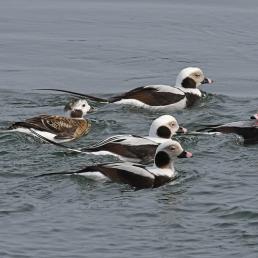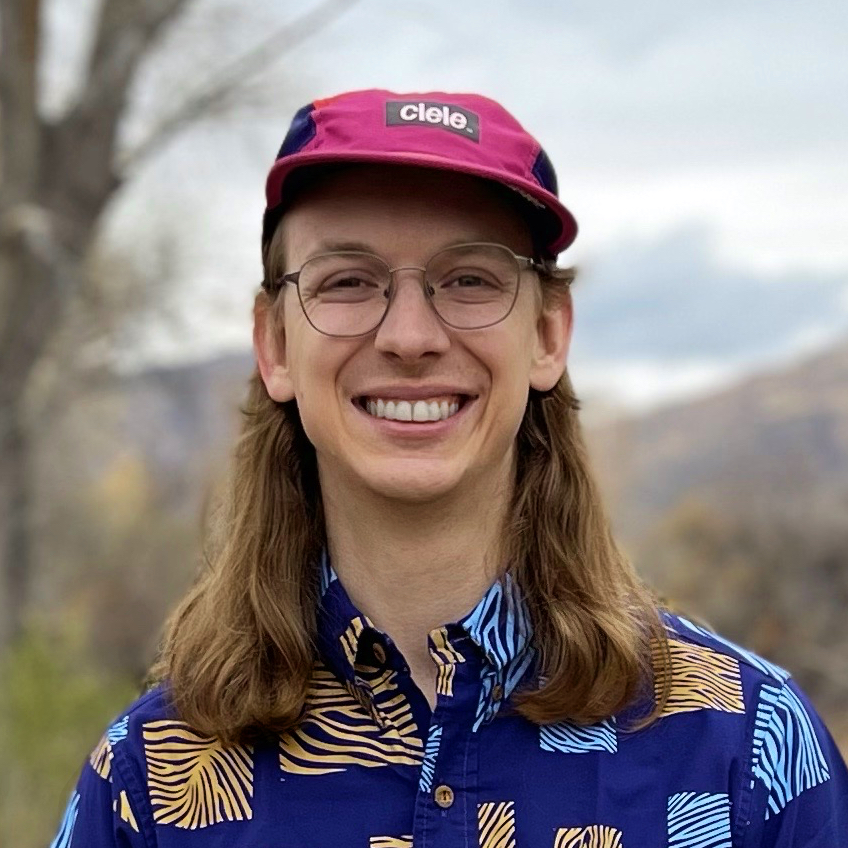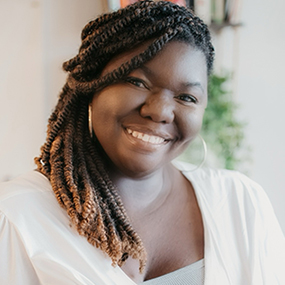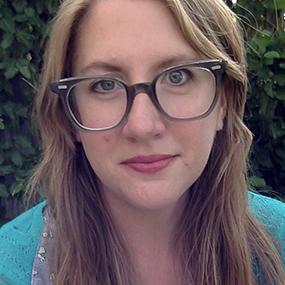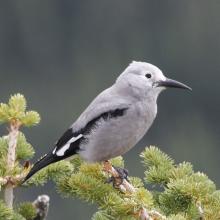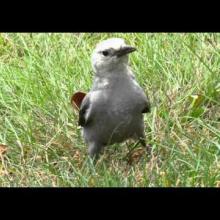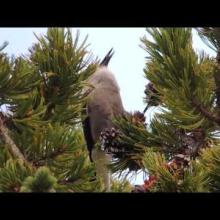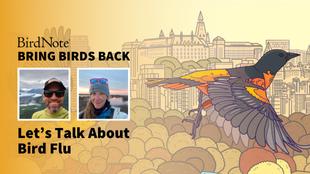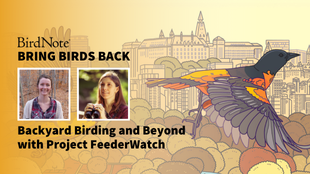

Join BirdNote tomorrow, November 30th!
Illustrator David Sibley and actor H. Jon Benjamin will face off in the bird illustration battle of the century during BirdNote's Year-end Celebration and Auction!

Clark’s Nutcracker and the whitebark pine have a strong mutualistic relationship: the tree is the bird’s best source of food, and the bird is the tree’s most dependable seed disperser. But several factors are putting the tree at risk — and the decline in whitebark pines is making that partnership less stable.
Peri Sasnett, a ranger at Glacier National Park and co-host of the park’s podcast Headwaters, joins Tenijah to talk all about the birds, their intricately interconnected ecosystems, and ways researchers are learning if and how the birds are adapting. Season 2 of Glacier National Park's podcast Headwaters is all about the charismatic whitebark pine and its role as a keystone species.
[Cheerful, joyful music starts with dawn chorus in the background]
Tenijah Hamilton: From BirdNote, this is Bring Birds Back. I'm Tenijah Hamilton.
So we recently heard this really cool podcast called Headwaters from Glacier National Park. The park is in northwest Montana in the Rocky Mountains — way up there, almost in Canada. And as you might expect from the park’s name, it’s cold and rugged and really beautiful.
The second season of Headwaters is all about a species that plays a huge role… tying the ecosystem there together: it’s… a tree,
[Music suddenly cuts out]
the whitebark pine.
[Music comes back in]
I swear, though, this is an exciting tree! The whitebark pine has a deep relationship with an incredible bird, Clark’s Nutcracker, which is what got us into this story. It shows the complicated ways species can work together, how we as humans think about our relationship to nature — and we’ll even take you out into the field to see how research is being done to protect these species.
[Music solo, then fades out]
Peri Sasnett is a co-host of the podcast Headwaters and a ranger at Glacier National Park. So before we dive in, Peri, I know you are a relatively recent new birder as well.
Peri Sasnett: Yes.
Tenijah Hamilton: So I would love to know how you got hooked. Uh, maybe we can, um, compare some notes.
Peri Sasnett: My spark bird. It was actually a bit of a wild goose chase involving some phalaropes. And I had, like, never birded before, but one of my friends had gotten into it. And she called me up and was like, “I've heard there were reported some Red-necked Phalaropes down south of town. And I think they might be Wilson's Phalaropes, but we have to check them out and see.” And I'm like, I don't know what a phalarope is. But sure! And so we went. And we did see some phalaropes. They were not the mysterious Red-necked Phalaropes, but Wilson's Phalaropes are also incredibly adorable. They're like little origami birds. I just— they were too cute. And I was like, this is kind of fun. Maybe I— maybe I'll tag along again. And so that's kind of where it all started.
Tenijah Hamilton: It kind of pays to be the adventure friend, huh?
Peri Sasnett: Oh yeah. And I just kept birding with these friends and I would not have said I was a birder. Would never have gone by myself until COVID happened. And then we were just going on walks every day. I started bringing my binoculars and I was like— like, I didn't think that I was a birder, but I was like, oh, that's a robin. And oh, is that a House Finch or a Cassin's Finch? How could I figure this out? Just sort of baby steps, like, oh, I can do this by myself. And, kind of, got into it from there.
Tenijah Hamilton: I see you in me, too. Like, this is— that's exactly how I got into it. And, um, it's really powerful because yes, honestly, like, look at us now.
Peri Sasnett: Right. And like, I mean, you know I'm a recent birder, but I was kind of recent to all things naturalist. Like I was a geologist. When I started working with the park service, I would've said I was not interested in alive things, that I was here to learn about the geology. And so it was sort of a journey to get interested in those things. But I remember my first couple seasons there, you'd go hiking up a trail and it's this long steep adventure and you're sweating and out of breath and you finally start to get up high and you hear this like, “ah, ah!” And it was a Clark's Nutcracker.
Tenijah Hamilton: What, um, an ace bird call that was.
Peri Sasnett: Oh, thank you. I have been practicing.
Tenijah Hamilton: Awesome.
The bird Peri just expertly imitated, Clark's Nutcracker, plays a big part in season 2 of Headwaters... but we’ll tell you more about that in just a bit. The star of the season is the nutcracker’s main source of food - the whitebark pine. The trees can grow as tall as 60 feet, and can live more than a thousand years. They live in high elevation forests in parts of the Rocky, Cascade, and Sierra Nevada mountain ranges. And Peri might just be this tree’s biggest fan:
What is it about the whitebark pine that like, you know— I see your face. They can't see your face. But I see your face and you're— you just look like, so, like, giddy and excited about it. So like, what, what's that? Tell us.
[Dainty, plucky music begins]
Peri Sasnett: They're just very charismatic. They're beautiful trees. They live in these high elevation forests that it takes a lot of work to get to.
Tenijah Hamilton: Before we go on, charisma is not something I think of a tree having. That's just a very human trait to me, I guess. And I'm starting to come around to the idea that it's ok sometimes to assign human traits to birds, to anthropomorphize them a bit. And, um, I think that can help you to understand and recognize them better. But how, Peri?! How does a tree have charisma?
Peri Sasnett: So if you think of a Christmas tree, like a little triangle shape. That's what subalpine fir look like. And that's most of the trees in our high elevation forests here. Like these little green cones. But then whitebark pine is kind of the opposite.
It's sort of like a candelabra where it's branches, like, grow out in this poofy way, kinda reaching up towards the sky. And so they really stick out. And um, a lot of them are dead. So there are these kind of twisted silver skeletons, kind of, blown all in one direction by the wind in this, like, harsh environment that it was living in. The tree skeletons will stand for decades after they've died. So yeah, just like, in life and in death, they're very eye-catching.
And it's like, they grow in these really harsh environments. Like you can imagine the winters we have here, let alone, like in the valleys, let alone where they're living, like thousands of feet up on these ridge lines. And so like the shapes of the trees kind of reflect the adversity that they face every day.
And yeah. They're so amazing. I love them.
Tenijah Hamilton: Uh, that's right. I'm just now taking a look through some photos of this tree. And it's really interesting how it's kind of contorted in these different ways. And it just does not look like the others. And like, I get, I get this more. Now it's making a little bit more sense.
[Dainty, plucky music ends]
Peri Sasnett: And there was a pretty clear moment for me where I went from feeling kind of like, yeah these trees are kinda cool. I think they’re gonna be an interesting topic for the podcast. They're connected to a lot of stories going on in the park, to like, realizing there’s a lot more there. It was with ShiNaasha Pete who’s a forester with the Confederated Salish and Kootenai Tribes. And we were going to visit Ilawye, or "The Great Great Grandparent Tree."
[Reflective, calm music starts]
Which is this huge old whitebark pine. And it's dead now, but it must have been at least a thousand years old. And it is huge. Like, only maybe 15 feet of it remain, but the root system is just massive. And so to see how ShiNaasha interacted with Ilawye was different from the way that I would have approached a tree or really any sort of experience in the outdoors.
Tenijah Hamilton: Let’s hear a clip of ShiNaasha from Headwaters…
ShiNaasha: Think of all of the energy that they have absorbed from everything that has happened over that time, whether it's bad or good, but then even when you have an opportunity to come to something so old and filled with wisdom from all of that energy absorbed. If you were to take that time to go to it, it's going to share energy with you.
Peri Sasnett: That was kind of the start of a shift to where, it's not just like, “What can I learn about this tree? That's a cool thing in the ecosystem.” But like, “what can I learn from this tree? What can I learn from this ecosystem? What can I learn from the whole natural world around me?” And that it is this relationship that you can build and foster. And that can be a really, I don't know, important thing.
ShiNaasha: Perseverance. That's what I see. You go through hardships, but you keep going. Sometimes in life, you have setbacks and sometimes you get the strength yourself to continue going by adapting, or you have a helping hand and you take that helping hand and move forward.
[Reflective, calm music fades]
Tenijah Hamilton: I love that. I love thinking about perseverance in the context of a tree that has withstood a lot, and it makes me think of how resilient nature is.
Peri Sasnett: Right. And like, these trees are up against so much and they're still here and we are giving them a helping hand and they're doing their best. We'll see how the story turns out, but it's definitely a story of perseverance.
Tenijah Hamilton: Alright, so speaking of what we can learn — I know the whitebark pine plays a pretty big role in the ecosystem at Glacier — I would love if you could tell me a little bit more about what it does there and how it affects the rest of the ecosystem.
Peri Sasnett: Yeah. So they are a keystone species. So they are important, not just because I think they're cool, but because they're important food sources for birds and squirrels and grizzly bears and black bears and so many different species. And they're important for a forest structure. Like, they're a pioneer species. So they're one of the first species to resprout after a fire, which is— you know, a burned area is a really harsh environment, like a harsh place for a little seedling to grow. So once a whitebark pine takes root, it provides some shade for the next species to come in. And so there's just all these different ways that it kind of shapes the high elevation ecosystem and touches all these other species and parts of the landscape.
Tenijah Hamilton: So I wanna talk more about it being a keystone species, can you tell me a little bit more about that?
[Music that sounds like the score to an 80s PBS science show begins]
Peri Sasnett: So it’s a term borrowed from a famous structure in architecture.
Architecture Narrator [from documentary]: The arch. Once built, an arch is incredibly strong.
Peri Sasnett: When you build an arch, you start with a column of rock on each side, and then as you start to build the arch and curve the columns together, you have to put up scaffolding
Architecture Narrator [from documentary]: Until the last stone was dropped in at the top: the keystone.
Peri Sasnett: It becomes self-supporting and you can take away the scaffolding. But if you take out the keystone, it all falls apart.
[Crashing noise; music halts]
And so a keystone species is kind of the same idea. It’s playing an outsized role in the ecosystem. And if you were to take it away…
Tenijah Hamilton: Devastation.
Peri Sasnett: Well I don't wanna necessarily say it would all fall apart, but there would be big consequences.
Tenijah Hamilton: Yeah. You know what? You go ahead and you advocate for your tree. If, if we don't protect the tree, then it all goes kablammy in some way or another.
Peri Sasnett: Yeah, it will all go sideways.
Tenijah Hamilton: Well, let's get a little deeper into that. You said that they're up against so much. So what are some of those challenges?
[Gloomy, slightly dissonant music starts]
Peri Sasnett: So one is the mountain pine beetle, and they're a native pest. But as the climate is warming, they are creeping up in elevation. So normally, in the past, temperatures get cold enough where whitebark pine lives, that it will kill the pine beetles larva. But as the climate warms, those temperatures come less and less often. And so pine beetles can attack whitebark pines much more effectively.
The novel threat that they're facing is blister rust, which is a fungus that came over to North America in the early 1900s. And that has been a real challenge. It enters the pores on the needles and moves down through the branches of the trees. And it strangles the branch and then eventually the whole tree and kills the tree. A small percentage of trees have some natural resistance to. And that's, kind of, what the restoration program is hinging on, but it's a very small percentage.
Tenijah Hamilton: Oh, goodness. They’re really getting attacked on a couple of different levels - the pine beetles, the fungus, and of course you have climate change which is making both of those threats worse.
Peri Sasnett: Oh yeah. It is a very messy and difficult problem to face. Cause you can't, like, disentangle one from the other.
[Gloomy, slightly dissonant music fades]
Tenijah Hamilton: And so obviously these are things that threaten the tree itself, but going back to your earlier point, this tree is a keystone species. So we're not just talking, again, just about the tree.
We're talking about the birds and, you know, all of the other life around there that depends on the tree for food. So I wanna dig a little bit more into Clark's Nutcracker, cause, you know, this is a bird show.
Peri Sasnett: Of course.
Tenijah Hamilton: So what did you learn about the bird throughout the course of season two?
Peri Sasnett: One of the things that stuck with me most is just their personality. And they're very, like, fun loving, feisty birds. They're very talkative.
[Clark’s Nutcracker chittering]
They have all kinds of different calls. Not just the one that I performed for you earlier.
[Clark’s Nutcracker call; beak rattle]
And like a lot of birds, you know, they're kind of all business. But the nutcrackers, like other corvids, at times, they seem like they're having fun. And so of course, as a human, — it's hard not to anthropomorphize. And so it's an appealing trait.
Tenijah Hamilton: You want the fun bird.
Peri Sasnett: Of course. And they're very fun birds.
Tenijah Hamilton: Who kind of helped you learn about this bird?
[Playful jazz music begins]
Peri Sasnett: So there's a team of people at glacier who are doing a research project on Clark Nutcrackers. So there's Lisa Bate
Lisa Bate: I'm a wildlife biologist here at Glacier National Park.
Peri Sasnett: And a grad student, Vlad Kovalenko.
Vlad Kovalenko: I am a Glacier National Park wildlife tech.
Peri Sasnett: And so they were two of the people that we talked with for the show about it. And Lisa, especially, has quite a fun way of describing things.
Lisa Bate: Okay. This is like the most amazing thing about Clark's Nutcrackers. They are the only birds in North America with a sublingual pouch. That means a pouch under the tongue. And they have co-evolved with whitebark pine to collect those seeds. They put 'em in that little pouch. And if you're lucky enough to see that start bulging, you can actually see the definition of the individual pine seeds.
Tenijah Hamilton: I can already tell that, um, she may be the most excited person about a sublingual pouch.
Peri Sasnett: She definitely gets the gold medal for that in my book.
[Playful jazz music fades out]
Tenijah Hamilton: Um, we know that this particular tree is a great food source, right?
Peri Sasnett: Yes.
Tenijah Hamilton: So tell us about that.
Peri Sasnett: Yeah. So the Clark's Nutcracker and the whitebark pine have this sort of famous, mutualistic relationship where the cones for the whitebark pine, unlike most trees, they don't open on their own to release their seeds. Someone needs to open them. And they're big, big pine nuts. You know, it's not like these little wind blown seeds from other trees. And so they're a very appealing food source, but most animals can't get into the cones. But Clark's Nutcrackers can. And so they'll pound away with their beaks to open up the cones and take the seeds out and they'll store them in their sublingual pouch, and then they'll go cache them a couple at a time around the forest floor. And they love to cache 'em in burned areas. And then…
Lisa Bate: They are so smart that they can remember where 98% of those seeds have been cashed, but it's the 2%, the one to 2% that they can't remember, or they don't get to. That's what germinates into the next generation of whitebark pine. So it is— it's just this fabulous mutualistic relationship that's evolved over the millennium.
Peri Sasnett: The trees rely entirely on the birds. There's no other way they can reproduce. The nutcrackers, they definitely rely on the tree because that's the best food source for them.
Like if you compare pine nuts to, like, these little teeny weeny little seeds from a Douglas fir, no contest. But they can eat other stuff. So the birds, they can eat all these other seeds, they can eat bugs, so they have a little more versatility. But those caches are a really key winter food source for them. And so without the tree— like without the bird, tree's done. Without the tree, the bird — that's one of the questions of this research project is: are nutcrackers still breeding in the park, like with the loss of whitebark pine? And one of the questions they're hoping to answer. But they have a little more versatility than the tree does.
Tenijah Hamilton: Hmm. Okay, so I know a little bit more about the questions that y'all are seeking to answer. How does that happen? How are y'all endeavoring to answer these questions, particularly, about what these Clark's Nutcrackers are doing when they can't subsist on the trees?
Peri Sasnett: So it's pretty amazing, actually. This technology that we have that we did not have 10 or 20 years ago. They put little backpack trackers on eight nutcrackers. It's only a few grams. They can make them so lightweight now that they're only a couple percent of the bird's body weight. So it doesn't really impact them. And so they can see where they are more or less in real time. Whether they're in the park. They can see if they've left the park. It's incredible. And so that's how they're trying to kind of, track their movements and figure out what they're doing and where they're breeding.
Tenijah Hamilton: That sounds like the cutest visual.
Peri Sasnett: I know a bird backpack!
Tenijah Hamilton: Little bird, little bird backpack. I'm sorry, you kidding me?
Peri Sasnett: Yeah, it's pretty adorable.
Tenijah Hamilton: I, I, I mean, if you could get me some bird backpack pictures, I would appreciate it.
[Jaunty piano music begins]
Peri Sasnett: They're not quite as cute as you might be envisioning, like, you know the kindergartener going to school
Tenijah Hamilton: Ok, it's real cute in my head, it's real cute in my head.
Coming up: Lisa and Vlad send their little backpack birds off to kindergarten. Well, if they can capture them in the first place. That's after the break.
[Jaunty piano music fades]
~MIDROLL~
Tenijah Hamilton: Alright, so we left off where Lisa and Vlad were getting ready to put these little tracker-backpacks on some Clark's Nutcrackers so they can study the birds’ movements, and see if they're still spending much time at all in the park. But this bird, as you mentioned, is a corvid. And if I have learned anything this season it's that corvids are pretty smart birds. So was catching them hard?
Peri Sasnett: So hard.
Tenijah Hamilton: Uh, okay, great. Love that. Need more— um, how Lisa and Vlad kind of, went about getting these transmitters, the cute little bird backpacks, on them.
Peri Sasnett: Yeah, so it was a process. And so they're doing this in the winter, in Montana. It's freezing. They have to, like, ski up a road to a closed road to get to the spot where they're even trapping the birds. It's a whole thing. If anything's amiss, they'll detect it instantly. And so they were using a bait called suet to try and attract them. I think it's mostly beef fat. So it's very appealing for the birds. But of course they're suspicious of anything new. So they hung the suet in a tree to get them used to it. Then they put the suet on the ground to get them used to that. Then they put the suet on the open bow net to get them used to that. Then they finally tried to trap them.
So they're sitting in little chairs, hidden in the woods with this long pull cord for the bow net. And they have to sit there, completely still, in the winter in Montana. It’s freezing.
Lisa Bate: We spent, like, hours. We spent days sitting there in a chair and we had to learn to just hold perfectly. Still it didn't we?
Peri Sasnett: If they even moved a finger, like, out of place, the birds would be like, gone.
Tenijah Hamilton: Wow.
Peri Sasnett: Yeah, I mean, they'd been waiting and waiting for a bird to land on this suet in the bow net on the ground. And so, you know, they have all these volunteers that are like, you know, hanging out in the woods, shivering and trying not to move, waiting for birds to land. And just seeing if they're going to, like, take the bait. And Lisa was in town, running errands or something. And she got a text from one of the volunteers that said:
Lisa Bate: Bird on Suet. Bird on ground. I just got goosebumps. I called Vlad. I'm like, “what are you doing tomorrow?” He's like, “I don't know, what am I doing?” I'm like, “we're trapping the bird.”
Tenijah Hamilton: It sounds so dramatic.
Peri Sasnett: Yes. They would take the birds into a cabin nearby to put the little backpacks on them. And
Lisa Bate: Every single bird that we handled had a different personality. There was the one that we came away with, uh, bruises all over our knuckles and then there was a, another one that was just cool as a cucumber.
Peri Sasnett: But they said that if they gave them a little stick to hold onto in their toes, that they would calm down. And I thought that was the cutest thing. And I guess it makes sense. Like, if you're a bird, you spend your life either flying or perching, and if you're not flying and you're not perching like, once they had that, they calmed down. But if they didn't have that, they were pecking at everything and grabbing at the towel that they were trying to process the birds on and all these things. And it was, I thought it was very relatable.
Tenijah Hamilton: Oh my goodness. Peri, science is real cute.
Peri Sasnett: I know.
Tenijah Hamilton: Science is real cute sometimes.
Peri Sasnett: It has its moments, for sure.
Tenijah Hamilton: Um, so, okay, so did you get a chance to actually see any of these backpack birds out in the wild?
[Driving, smooth guitar music starts]
Peri Sasnett: Yeah. Well, it was very exciting because we had gone out with Vlad in the field to spend a day out, like tracking nutcrackers and trying to find the ones with the antennas on them.
You can track them in real time, So Vlad can see where the birds are, generally, in his office and then go out in the field. But I mean, they could have left or something. So there's sort of an element of luck to it.
You have to get close enough, kind of, within range. Then when it does, it kind of says in this robot voice,
Transmitter Robot Voice: 1 0 3.
Vlad Kovalenko: Woo. That's good news.
Peri Sasnett: So it's transmitting?
Vlad Kovalenko: Yeah, someone's transmitting.
Peri Sasnett: And the higher the number is, the closer you are to the bird.
Transmitter Robot Voice: 1, 5, 6.
Vlad Kovalenko: Yeah, it should keep increasing.
Transmitter Robot Voice: 2, 0, 8.
[Nutcracker call]
Peri Sasnett: What was that?
Vlad Kovalenko: There's our friend. Our nutcracker. Oh, one on the top of that tree.
Peri Sasnett: Oh yeah.
Oh, there's a ton of em.
Vlad Kovalenko: All right. Gimme an antenna please.
Peri Sasnett: We'd seen so many nutcrackers, none with antennas.
Tenijah Hamilton: Mm-hmm.
Peri Sasnett: But we'd been hiking all along this Ridge, all throughout their habitat.
And finally, at the end of the day, we heard some more nutcrackers and we're like, probably not our bird still. But the antenna was like 2, 7, 5. And we were like, *gasp* there's one nearby. And then one of the nutcrackers landed near us
Vlad Kovalenko: The top of this really thin tree.
Michael Faist: That's got an antenna.
Vlad Kovalenko: It does?
Michael Faist: Yeah.
Peri Sasnett: A big fat one. Oh I see a bunch of opened cones. It's perched right on top of that whitebark. I haven't seen it drill open the cones yet, but see, there's a bunch of already opened cones at the top of that white bark.
Vlad Kovalenko: Gosh, they’re fun to watch.
Tenijah Hamilton: This sounds really fun. Like, it sounds like bird watching on adrenaline.
Peri Sasnett: Yeah, well it's a treasure hunt, kind of. It's not just like looking for the birds. It's like this specific bird. And I know it's here, but where is it?
Tenijah Hamilton: I love that. Um, there's so much of hearing you kind of, even go back and tell this story again to me, where I'm like, there's just so much joy in its experience. Um, and I love that those two things can coexist, right?
[Driving, smooth guitar music fades]
Peri Sasnett: Yeah and, especially with a story like this, which you could see it as a pretty sad story, but that's not all that it is. There is sadness there and there is loss of so many of these trees. But there's also so much joy in seeing these birds like frolicking around and getting to know these trees. And yeah, like building my relationship with all of these species and with this ecosystem, and then hope in seeing the work that people are putting into the restoration program.
Tenijah Hamilton: Yeah. I guess my next thing is I wanna know— and kind of taking this from what you've said thus far, um, and what's next for these trees, what's next for these birds. What do we know about what can potentially come after this point? I'm thinking about, you know, this really cool mutual relationship you've been talking about. I'm thinking about what happens if the whitebark pine declines. Uh, what would happen?
Peri Sasnett: Well, so if whitebark pine went extinct, that would— I guess if we start with the nutcracker, they would leave. They would probably go down to Utah. See if they can get the pinyon pine nuts. They would probably adapt, but there would definitely be fewer of them. And they probably would not be here in the same numbers, if at all.
But yeah, if you look at all these other species, it's like grizzly bears and black bears; when cone crops are worse, there are more bears at lower elevations where people live. They get into more trouble. There's these ripple effects all throughout the ecosystem for all the species that depend on whitebark pine.
So that's why there's this big restoration program.
Tenijah Hamilton: Yeah, and to be fair, you know, there is still a lot of hope as you were just saying. And we don't know exactly what will happen yet. With so much interconnectedness, it's hard to be certain exactly where the ripples end up. But this is all a part of the serious threats to the tree.
Peri Sasnett: Yeah. And certainly, like we said, there is that percentage of the trees that are naturally resistant to the blister rust, at least. So I think, from the people we talked to, there were kind of different prognoses. Some people are more optimistic than others, but yeah, the more optimistic scenarios are sort of, if the restoration effort is successful and we can have whitebark pine persist on the landscape, that's, that's the dream and the hope.
Tenijah Hamilton: Hm. Peri again, there seems like so much that, um, was really gratifying about this, but I'm curious about what really stuck with you from telling this story and working on this project.
Peri Sasnett: Yeah, kind of back to where we started with that day with ShiNaasha and with everyone else that we talked to this season, just learning that this is a relationship. Like, we are part of the ecosystem, you know. I think it's really easy to see ourselves as separate, like, that's nature and we're over here. And humans, we're the people that are destroying the nature. You know, I mean, that's kind of how the national parks concept came about. It was like, well, first we need to remove Indigenous peoples. Then we need to draw a line around these places to keep the people out. So we don't ruin the nature.
[Light, contemplative music begins]
And seeing it in a totally different way, as like, humans are part of this ecosystem. We have a role in it, we can have a relationship, we can be stewards, we can learn from the natural world is just a totally way different way of seeing things.
Tenijah Hamilton: I've, similarly in my bird journey, which still feels so much in its infancy. The biggest things I've learned are really just about the relationships between people and nature, and how to reframe my thinking from thinking that nature is happening outside of me. And outside of how I exist in the world, to now thinking about myself as a part of and living and surviving and being alive in concert with it. Like together. And it's that mind shift that I'm hearing you kind of allude to as well.
Peri Sasnett: Yeah. Like as a birder, I think, instead of imagining birding as kind of like a zoo where you're the birder and there's a glass wall, and you're just seeing what they're doing. It's like, to walk through the forest and like hear birds, like, talking about you. You know, like alarm, alarm, there's a human.
[Nutcracker call]
Like, like you're part of the experience. And you can hear them reacting to your presence. And if you're, you know, quiet enough and part of the ecosystem enough, then they won't alarm call. It's great.
[Nutcracker call]
[Contemplative music ends]
Tenijah Hamilton: I've learned so much from you and I, I'm just even more excited to hear what's coming next for headwaters. What can we look forward to in season three?
Peri Sasnett: So season three will be a history season.
Tenijah Hamilton: Ah!
Peri Sasnett: Yeah. So the pre-park history from the pleistocene through the 19th century, leading up to the formation of the park in 1910 and the formation of the park service in 1916. So kind of looking at the history that led to the formation of the park, and then tying that into today, of like, how do these stories that seem like the very distant past affect us every day. So it's been very fun to work on and I'm excited for it to come out this winter.
Tenijah Hamilton: I'm really excited. And I cannot wait to hear all the, kind of, the in-depth research and the new insights you guys pull out.
Peri Sasnett: Thank you.
[Conclusive, reflective music starts]
Tenijah Hamilton: Peri Sasnett is co-host of the podcast Headwaters, which is made possible by the Glacier National Park Conservancy. If you are now the whitebark pine’s biggest fan, good news! There are five episodes about it from Headwaters you can listen to right now — and their next season starts early 2023. Just search for 'Headwaters' in your favorite podcast app.
Bring Birds Back is produced by Mark Bramhill and me, Tenijah Hamilton. Our production assistant is Sam Johnson. Our fact checker is Conor Gearin. Our content director, and editor this season, is Allison Wilson. Music is by Cosmo Sheldrake, Blue Dot Sessions, and Sam Johnson. Special thanks to Viki Merrick and of course the Headwaters team at Glacier.
[Conclusive, reflective music ends]
About guest Peri Sassnet:
Peri Sasnett is a science communicator with the National Park Service, using film, audio, writing, and photography to connect park audiences with scientific stories. Originally trained as a geologist, she has held a variety of interpretive and scientific roles in Glacier, Joshua Tree, Grand Teton, Grand Canyon, and Yosemite. Peri is an avid birder, hiker, and old time fiddler. She produced Season Two of Headwaters with Michael Faist, Andrew Smith, and Daniel Lombardi, with support from the Glacier National Park Conservancy.
